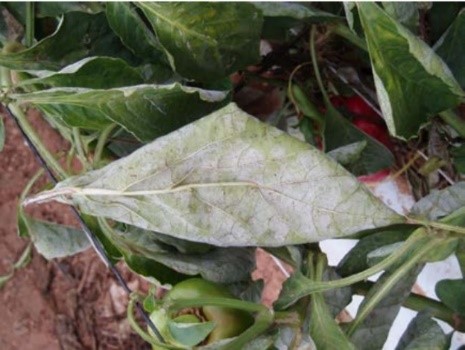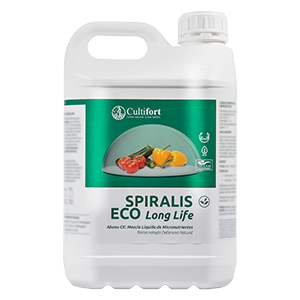Powdery mildew is one of the most important and widespread diseases in horticultural crops in southern Spain. This disease is commonly found in cucurbit and solanaceous crops, specifically in cucumber, watermelon, tomato and bell pepper (F. López Ruiz – experimental station La Mayora (CSIC)).
Specifically, the southeast of the peninsula, which includes Almeria and Murcia, is the area with the largest cultivated area of solanaceae and cucurbits in the continent, both in protected and open-air cultivation. The socioeconomic importance of these crops makes it necessary, therefore, to keep under control incidents such as the one mentioned above.
Powdery mildew is a disease caused by fungi of different species, such as Erysiphe orontii, Podosphaera fusca, Oidium neolycopersici, Leveillula taurica. These are biotrophic organisms that feed on living plant cells and do not survive in the absence of living cultures. Their optimum development conditions are 20-30ºC and 70-80% relative humidity.

Powdery mildew on bell pepper
This fungus grows and develops on the underside of leaves, mainly petioles and stems. It gives rise to a whitish or ashy hair on leaves and stems that facilitates its identification. As the leaves are the most affected area, it ends up affecting the reduction of photosynthetic rates, which ultimately affects the reduction of productive yields.
In order to control powdery mildew without fungicides, avoid damage caused by the fungus and increase resistance to stress, Cultifort proposes an effective alternative based on elicitation.
The mode of action of these active ingredients focuses on activating the self-defense mechanisms of plants, mainly reducing the impact of fungal diseases. In this sense, certain groups of algae present eliciting active elements among which groups of phenolic compounds stand out, presenting an excellent biostimulant effect and a representative role in the defense against diseases. These phenolic extracts act as mediators of the SAR (systemic acquired resistance) mechanism that plants have to defend themselves against fungal and bacterial disease attacks.
From the technical department R + D + i of Cultifort, we recommend SPIRALIS ECO Long Life, fruit of the development of an innovative line of research based on Natural Defensive Biotechnology.
SPIRALIS ECO Long Life is a biostimulant that acts mainly in a preventive and regenerative way, supplementing the action of the precise selection of phenolic extracts with complexes of organic acids and peptides from the same sources of extraction of the algae studied, which facilitate their assimilation by the plant in a systemic way, both ascending and descending and enhance the bioprotective effect against various abiotic factors or any incidence that directly influences the general health of the crop.
The specifically selected peptides, as well as the organic acids it contains, promote and induce the rapid synthesis of defense molecules such as: PR Proteins, Thionins, Phytoalexins and other Phenylpropanoids. In addition, other beneficial metabolic pathways are activated, such as systemic acquired resistances (SAR and LAR).
In its set of selected active ingredients, SPIRALIS ECO Long Life, acts under the following modes of action:
1) Promoter of PR or Pathogenesis-Related Proteins (Pathogenesis-Related), which are defined as proteins auto-synthesized by the plant when attacked by a pathogenic microorganism. These proteins have microbial activity and prevent the subsequent colonization of the pathogen, thus directly inducing protection against pathogenic fungi.
2) Precursor of phytoalexins, secondary metabolites of diverse chemical nature, mainly flavonoids, of low molecular weight, synthesized after infection, generating and encouraging resistance when reaching sufficient concentrations to inhibit the pathogen.
3) Its content in thionins, as peptide groups formed by groups of 45-47 amino acids, would be endowed with four disulfide bridges, so they have a direct fungistatic activity, adhering directly to the cytoplasmic membrane, forming transmembrane pores in microbial cells, so we have a dual activity summarized in:
– A chemical mechanism, consisting of energy loss and the formation of an ionic gradient across the damaged membrane.
– A biochemical mechanism, consisting of the entry of significant concentrations of antimicrobial peptides into the cell that bind to intracellular molecules, causing a profound alteration of cell metabolism.
On the other hand, it is intended to be implemented to improve the health status with nutritional elements such as manganese and zinc in chelated form.


